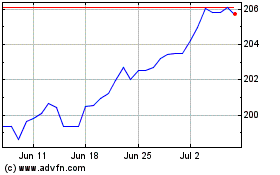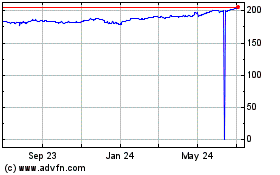China's Manufacturing Sector Logs Robust Growth
September 29 2020 - 9:50PM
RTTF2
China's manufacturing sector logged a strong momentum in
September driven by robust domestic and foreign demand after the
easing of lockdown measures, survey data from IHS Markit showed
Wednesday.
The Caixin manufacturing Purchasing Managers' Index edged down
to 53.0 in September from 53.1 in August.
A score above 50 indicates expansion in the sector. Operating
conditions strengthened in each of the past five months. According
to the official survey data released by the National Bureau of
Statistics, the factory PMI advanced to 51.5 in September from 51.0
in August. Likewise, the non-manufacturing PMI came in at 55.9
versus 55.2 in August.
New orders grew the most since the start of 2011 driven by
robust external demand, private survey data revealed. New export
business rose at the quickest pace since August 2017.
Manufacturers said higher inflow of work led them to raise
production in September though the pace of growth softened.
Employment levels were broadly stable, which brought about an
end to a period of job shedding that stretched back to January.
Manufacturers raised their purchasing activity again in
September, and at the fastest rate since January 2011. Cost
inflation quickened from August but output charges increased at the
slowest pace for three months.
Chinese manufacturers were generally confident that production
would rise over the next 12 months. Notably, the degree of positive
sentiment improved to a three-month high.
The strength of the manufacturing sector will take some of the
pressure off policymakers going forward, Wang Zhe, senior economist
at Caixin Insight Group said.
"However, the job market remains worrisome, as the improvement
in employment relies on a longer-term economic recovery and a more
stable external environment. In the near future, great
uncertainties remain about the overseas pandemic and the U.S.
presidential election," said Wang.
In the near term, fiscal support and improving foreign demand
will keep activity in industry and construction strong, which in
turn should shore up consumer sentiment and household spending,
Julian Evans-Pritchard, an economist at Capital Economics,
said.
"The upshot is that we are entering a period of above trend
growth, which should help absorb the remaining slack in the labour
market and allow for some policy tightening next year," the
economist added.
Sterling vs Yen (FX:GBPJPY)
Forex Chart
From Mar 2024 to Apr 2024

Sterling vs Yen (FX:GBPJPY)
Forex Chart
From Apr 2023 to Apr 2024
